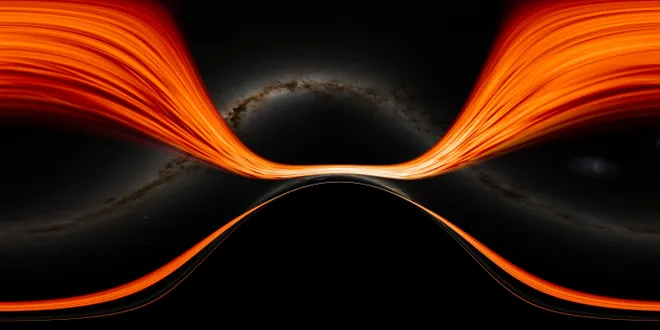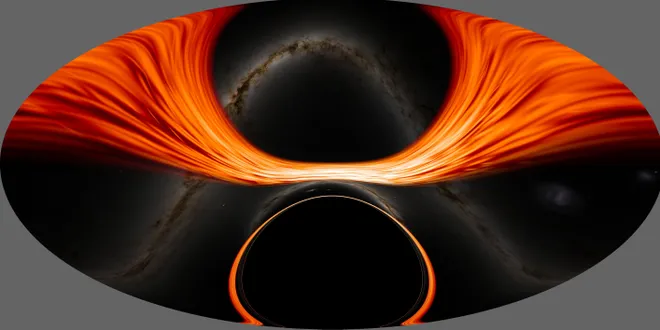What happens if you fall into a black hole? NASA simulations provide an answer.
Anyone who has watched Matthew McConaughey plunge into a supermassive black hole in "Interstellar" may think they have a rough idea of what it'd be like to encounter one of these terrifying cosmic formations.
But a Hollywood blockbuster set decades in the future is no comparison to the real thing – even if it was directed by Christopher Nolan. Ten years after "Interstellar" hit theaters, NASA is now giving us a more personal experience of what would happen if we were to fall into a black hole.
No, not even the most intrepid spacefarers are yet able to get anywhere near these massive behemoths, where the pull of gravity is so intense that even light doesn't have enough energy to escape their grasp.
In the meantime, simulations released Monday instead simply imagine what a person may see while plummeting toward a black hole's event horizon to their inevitable death. Yet another simulation released by NASA shows the imagined point of view of an astronaut flying past a black hole as space appears to bend and morph.
"I simulated two different scenarios, one where a camera – a stand-in for a daring astronaut – just misses the event horizon and slingshots back out, and one where it crosses the boundary, sealing its fate," said Jeremy Schnittman, an astrophysicist at NASA’s Goddard Space Flight Center in Greenbelt, Maryland who produced the visualizations.

Horsehead Nebula:New photos from NASA's Webb telescope shows iconic 'mane' in stunning detail
NASA simulations show plunge into black hole
While humanity has learned much more about black holes in recent years since the first one was identified in 1964, the objects remain notoriously mysterious.
NASA's new visualizations, available on Goddard's YouTube page, erase some of that enigma. The two visualizations are divided into one-minute trips rendered as 360-degree videos that allow viewers to look around during the trip, and extended versions with explanations to guide viewers on what they're witnessing.
The destination of the simulation is a virtual supermassive black hole with a mass 4.3 million times that of Earth's sun, a size equivalent to the monster Sagittarius A* located at the center of our Milky Way galaxy.

The first simulation shows the viewer approaching the black hole from around 400 million miles away and rapidly falling toward the event horizon – a theoretical boundary known as the "point of no return" where light and other radiation can no longer escape. Like Sagittarius A*, the event horizon of the simulation spans about 16 million miles.
Cloud structures called photon rings and a flat, swirling cloud of hot, glowing gas called an accretion disk surrounding the black hole serve as a visual reference during the fall. As the camera reaches the speed of light, the accretion disc becomes more distorted as space-time warps.
Once inside the black hole itself, the viewer rushes toward the black hole's one-dimensional center called a singularity, where the laws of physics as we know them cease to exist.
The simulations were made using the Discover supercomputer at the NASA Center for Climate Simulation, and generated around 10 terabytes of data, which is about half of the estimated text content in the Library of Congress.
Second simulation shows viewer narrowly escaping black hole
Astronomers divide black holes into three general categories based on mass: stellar-mass, supermassive, and intermediate-mass.
Stellar-mass black holes, which form when a star with more than eight times the sun’s mass runs out of fuel and its core explodes as a supernova, are even less ideal to find yourself falling into than its supermassive counterpart, Schnittman explained.
“If you have the choice, you want to fall into a supermassive black hole,” Schnittman said in a statement. “Stellar-mass black holes, which contain up to about 30 solar masses, possess much smaller event horizons and stronger tidal forces, which can rip apart approaching objects before they get to the horizon.”
This occurs because the gravitational pull on the end of an object nearer the black hole is much stronger than that on the other end. Falling objects stretch out like noodles, a process astrophysicists call spaghettification. For this simulated black hole, it would only take about 12.8 seconds for the viewer to meet their end by spaghettification.
The alternate simulation shows a viewer orbiting close to the event horizon but escaping to safety before ever crossing it.

If an astronaut flew a spacecraft on this 6-hour round trip, the explorer would return 36 minutes younger than those who remained on a mothership far away, NASA explained. This is another concept that will be familiar to "Interstellar" fans and is due to time passing more slowly near a strong gravitational source.
"This situation can be even more extreme," Schnittman said. "If the black hole were rapidly rotating, like the one shown in the 2014 movie 'Interstellar,' (the astronaut) would return many years younger than her shipmates."
Eric Lagatta covers breaking and trending news for USA TODAY. Reach him at elagatta@gannett.com
Disclaimer: The copyright of this article belongs to the original author. Reposting this article is solely for the purpose of information dissemination and does not constitute any investment advice. If there is any infringement, please contact us immediately. We will make corrections or deletions as necessary. Thank you.




